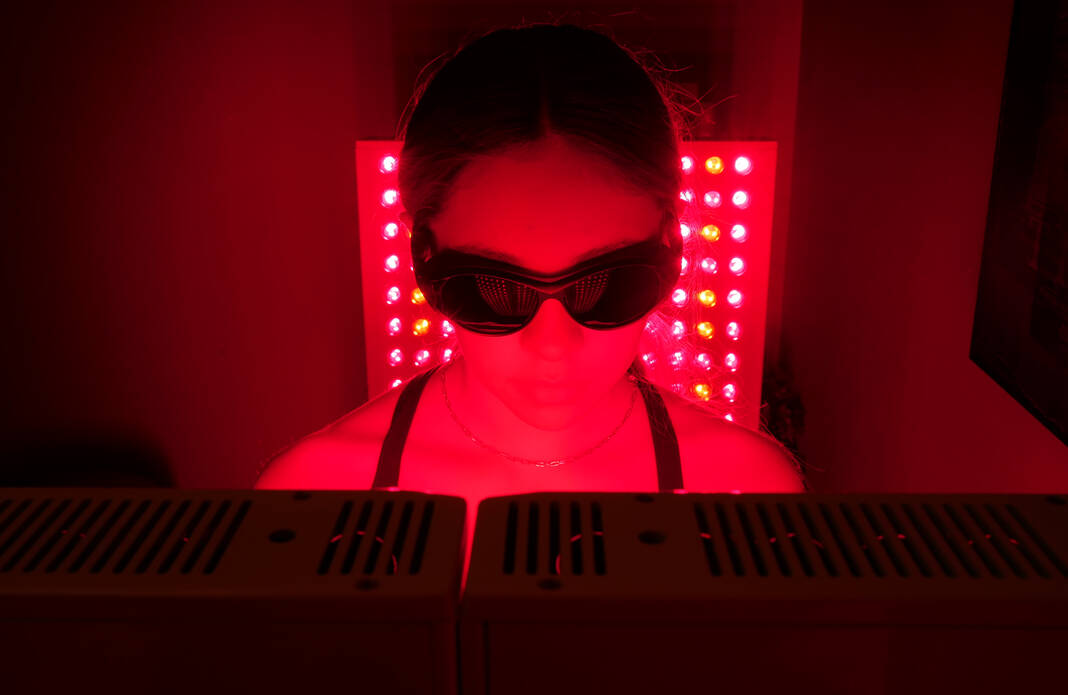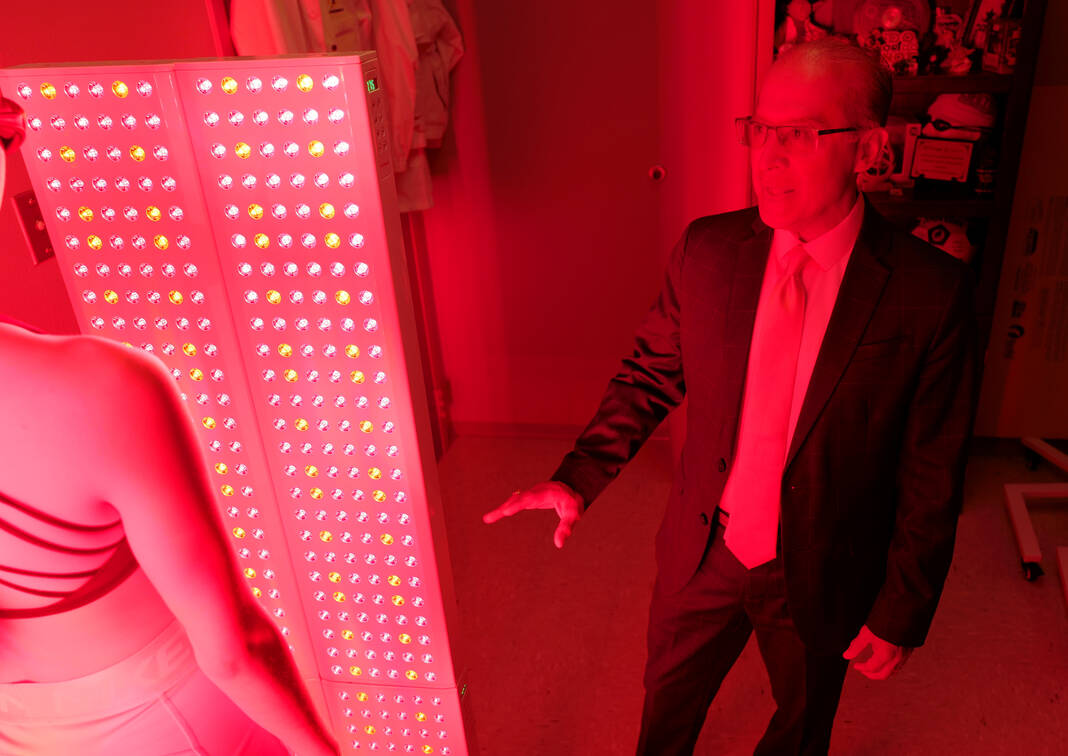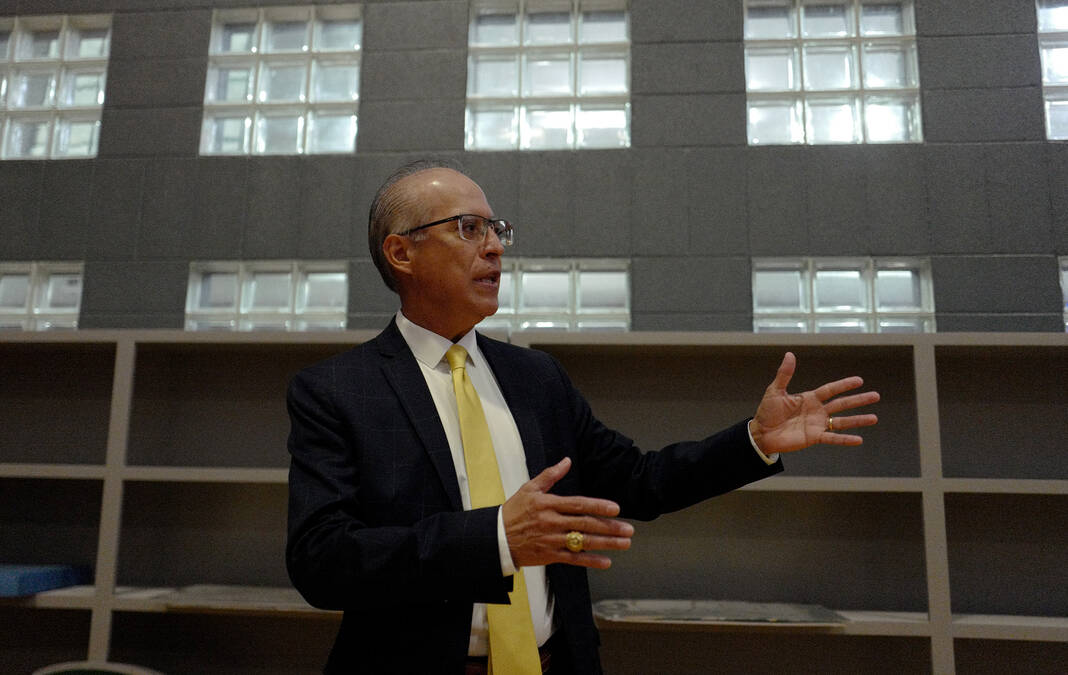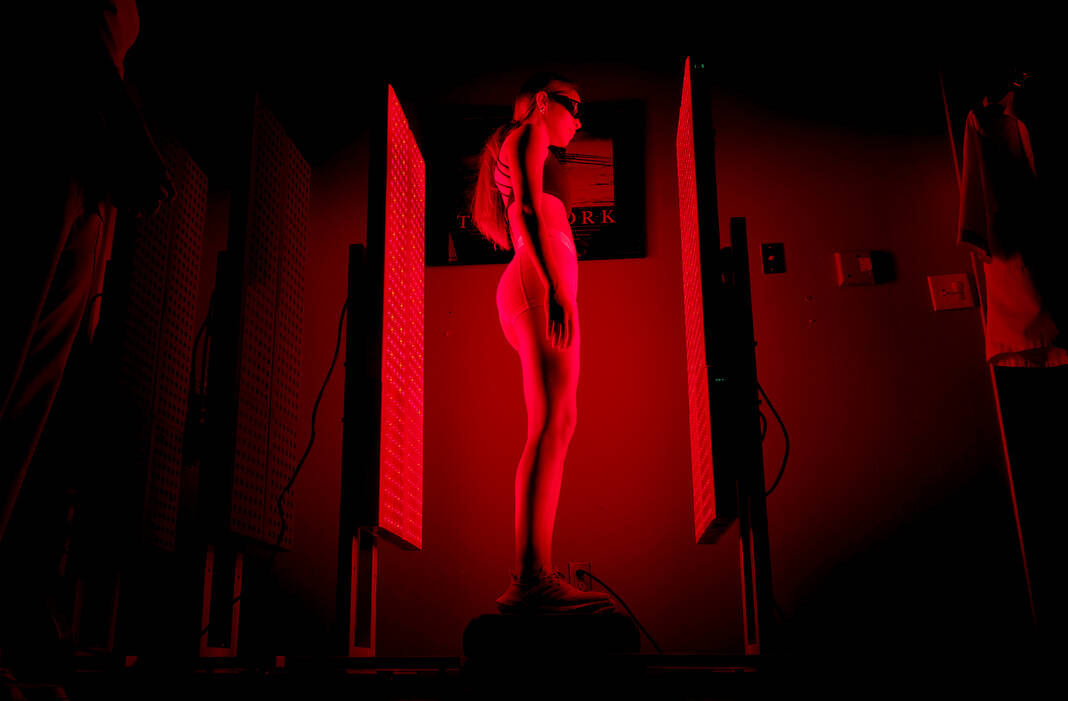|
Only have a minute? Listen instead
Getting your Trinity Audio player ready...
|
EDINBURG — Ever wanted to feel like Superman? Well, according to a professor at the University of Texas Rio Grande Valley, there is a light therapy that improves the body’s recovery process by harnessing the power of sunlight without harmful ultraviolet rays.
At 630 to 850 nanometers, the unit of measurement in the light spectrum, red and infrared light therapy is a type of treatment used to speed the healing process for certain injuries, a process UTRGV is using for athletes and the general public at no cost — for now.
For Juan Gonzalez, associate professor, red and infrared light therapy is a step in the right direction when searching for an anti-inflammatory treatment. It’s also new to the Valley, he said, adding that the next closest location with a recovery room being at Texas A&M University.
Although not a new science, Gonzalez explained that research has shown infrared light therapy improves recovery time at a cellular level.
Despite being skeptical of the therapy, Gonzalez was determined to study the treatment and its effects.
Throughout the COVID-19 pandemic, he bought a redlight wrap and would use it on his legs an hour before his run.
“I started feeling like Robocop,” Gonzalez said, adding that as he continued to study the treatment he found continuous results where his legs felt more refreshed and energized. “I started noticing consistently that every time I used it, it helped me run better, but then every time I used it after a run it helped me recover.”
He explained that, unlike a laser, red and infrared light are noncoherent, meaning the light spreads throughout the body rather than going through directly.
Red light (630 nm) penetrates just below the skin and helps reduce inflammation, which can therefore treat skin conditions such as acne, scars or even wrinkles by improving collagen production. While near-infrared light (850 nm) penetrates to the bone, helping muscles that are fatigued recuperate better and expedite healing through mitochondrial adaptations.
“Red light does not cure anything. What red light does is that it helps the body with its own natural processes to become more efficient,” Gonzalez said, adding that the light is absorbed by photoreceptors in the cells that kickstart the body’s natural healing process.

Not only does it assist in recovery but also causes vessel dilation, which increases blood flow throughout the body and provides an aerobic boost.
According to Gonzalez, red and infrared light are not only useful in a sports capacity but can also be applied in clinical disease treatment.
Due to the light’s anti-inflammatory components and non-invasive nature, it can help with diseases such as diabetes and arthritis.
Gonzalez, himself a 61-year-old Type 2 diabetic, explained that the therapy helps bring down inflammation allowing his body to process glucose better.
The professor said the treatment is new to the Valley and hopes to expand its use as the area’s first-ever Redlight Recovery Room, which would be located at the university’s Health and Physical Education Building II in Edinburg. A target date of opening is pending further work.
However, he already purchased 15 Infraready Plus panels at $45,000 for the clinic. He plans to place 10 panels in one room that will be used for the UTRGV volleyball team and other sports teams, while the other five will be placed in a curtained area outside the room.
As soon as the clinic is up and running, Gonzalez plans to make his website available for the public to register for the treatment. In order to receive the therapy, one must not be currently under any cancer treatment, epileptic or pregnant.
“There are no side effects to red light and infrared light therapy other than you’re going to feel better, you’re going to reduce inflammation and you’re going to process naturally what your body needs to do,” Gonzalez said.
As of now, he is treating patients in his office at the Edinburg campus with two redlight panels.
The patient stands between the two panels, which emit red and infrared light, for about 10 to 12 minutes which Gonzalez explained provides optimal results.

Gonzalez is currently treating various athletes and members of the community, including Lydia Aguilera, associate dean for interprofessional education at UTRGV’s College of Health Professions, and her 86-year-old mother.
Aguilera, 66, explained that her mom often complained about being in pain and had trouble walking.
Although she didn’t know the extent of the treatment’s effect, she did notice that as they made their way back to their vehicle her mother was able to take a couple of steps on her own.
Four hours after an appointment, she was shocked to get a phone call from her mom explaining that she felt relief from the pain she had suffered with for so long.
“I was so surprised to see her calling me because I knew that usually someone else calls me for her,” Aguilera explained.
She even remembers her mom’s words: “I just wanted to tell you that I feel so good. I don’t feel any pain … I feel so much better.”
“She sounded so happy,” Aguilera added.
Aguilera explained that her mother is returning for a follow-up session on Saturday.
Soraida Urbina, 51, is among Gonzalez’s other patients receiving the therapy to help with joint pain.
Joint pain was a side effect of anastrozole, a medication prescribed to Urbina after doctors told her she was cancer-free. She explained that the pain was unbearable and often limited her movement.

“There were some days I couldn’t even get up from the bed. It was very hard for me, I needed to roll over and push myself toward the mattress, by the time I put my feet down … it was very painful,” Urbina said, adding that she couldn’t even hold a cup of coffee due to the pain.
She felt depressed having to depend on her daughters to help her with simple tasks.
But after her first light therapy session things took a turn for the better. In fact, she recalled feeling about 60% better, making her hopeful for her next appointment.
Now after a week-and-a-half of receiving the therapy every three days, Urbina explained that she feels no joint pain.
“I can’t wait to come back every three days to have the treatment because I am pain-free and I am able to do more things,” Urbina said. “God brought me Dr. Gonzalez at the best possible time.”
Camryn Mejia, a freshman at McAllen Memorial High School, stood between the panels on Wednesday demonstrating the simplicity of the therapy.
The machine made a soft humming noise as the timer counted down. After the 10-minute session, Mejia explained she felt energized and pain-free.

The 14-year-old athlete has been receiving the therapy for about two months and attributes the treatment as part of her success in both track and soccer.
“It helps with soreness and other things like preventing injuries, so it’s been keeping me kicking,” Mejia said.
She explained that depending on how her body feels, she will either receive the therapy prior to her training to ease any muscle aches or after her training to prevent soreness.
Although Aguilera, Urbina and Mejia received therapy for different reasons, they each agreed that the benefits of the treatment were noticeable and worth it.
According to Gonzalez, red and infrared light therapy not only helps as an anti-inflammatory treatment but also helps “reset” the body’s Circadian rhythm, the body’s internal clock, allowing one to sleep better. Something each of them also agreed on adding that they’ve each woken up feeling well-rested after the treatment.
There is currently no price set for how much treatment would cost, but Gonzalez’s plans are to make them affordable to the public.
Anyone interested in receiving the treatment can contact Gonzalez via email at [email protected].




